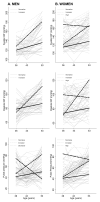Population heterogeneity in trajectories of midlife blood pressure
- PMID: 22249241
- PMCID: PMC3355297
- DOI: 10.1097/EDE.0b013e3182456567
Population heterogeneity in trajectories of midlife blood pressure
Abstract
Background: We investigated whether there are subgroups with different underlying (latent) trajectories of midlife systolic blood pressure (BP), diastolic BP, and pulse pressure in a UK cohort.
Methods: Data are from 1840 men and 1819 women with BP measured at ages 36, 43, and 53 years. We used unconditional growth mixture models to test for the presence of latent trajectory classes. Extracted classes were described in terms of a number of known lifetime risk factors, and linked to the risk of undiagnosed angina (Rose questionnaire) at age 53 years.
Results: In both sexes for systolic BP, diastolic BP, and pulse pressure, there was a large "normative" class (>90% of the sample) characterized by gentle annual increases (eg, an increase in male systolic BP of 0.9 mm Hg/year [95% confidence interval = 0.9 to 1.0]), with a smaller class for whom the rate of increase was high (eg, an increase in male systolic BP of 3.1 mm Hg/year [2.8 to 3.4]). In women, there was an additional class for whom BP was high at age 36 and remained high. Persons in the "normative" classes were, on average, heavier at birth and taller at age 7 years, had a lower midlife body mass index, and were less likely to be on antihypertensive medication compared with those in other classes. Among those with no diagnosed cardiovascular disease, those in the classes with more strongly increasing systolic BP and pulse pressure were at greatest risk of angina.
Conclusion: Our study suggests that in midlife the majority of the population have a gentle underlying increase in BP, but that there also exists an important subgroup in whom BP increases much more markedly. These classes may be useful for identifying those most at risk for cardiovascular disease.
Figures


References
-
- Lewington S, MacMahon S. Blood Pressure, Cholesterol, and Common Causes of Death: a Review. Prospective Studies Collaboration. Am.J.Hypertens. 1999;12(10 Pt 2):96S–8S. - PubMed
-
- Lewington S, Clarke R, Qizilbash N, Peto R, Collins R. Age-Specific Relevance of Usual Blood Pressure to Vascular Mortality: a Meta-Analysis of Individual Data for One Million Adults in 61 Prospective Studies. Lancet. 2002 Dec 14;360(9349):1903–13. - PubMed
-
- Health Survey for England 2006. 2008;Volume 1. Cardiovascular disease and risk factors in adults
-
- Benetos Athanase. Does Blood Pressure Control Contribute to a More Successful Aging? Hypertension. 2005 Aug 1;46(2):261–2. - PubMed
-
- Bazzano LA, Whelton PK, He J. Blood pressure in westernized and isolated populations. In: Lip GYH, Hall JE, editors. Comprehensive Hypertension. Mosby, Elsevier; Philadelphia: 2007. pp. 21–30.
Publication types
MeSH terms
Grants and funding
- U.1230.00.004.00001.01(92721)/MRC_/Medical Research Council/United Kingdom
- MC_UP_A620_1015/MRC_/Medical Research Council/United Kingdom
- MC_U105292687/MRC_/Medical Research Council/United Kingdom
- MC_U123092721/MRC_/Medical Research Council/United Kingdom
- U.1052.00.013.00003/MRC_/Medical Research Council/United Kingdom
LinkOut - more resources
Full Text Sources

